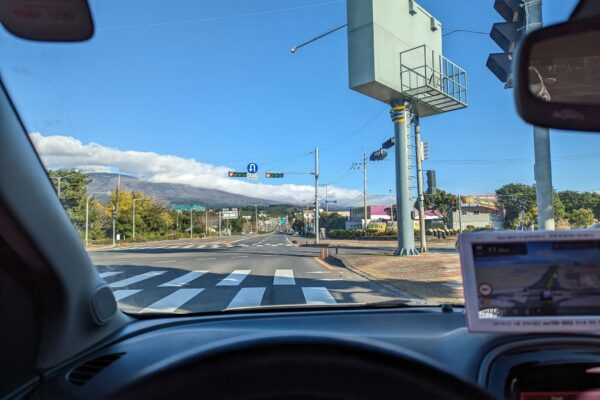
For free-and-easy travellers to Jeju, there are two options to get around: use public transport or get a rental car. I was originally considering the former, but fortunately, ultimately decided to rent a car. I think it’s the best option to get around Jeju island on your own, and if you can drive, you should do this too.
This post is about driving in Jeju, South Korea. It is from the perspective of a foreigner, particularly Singaporean, trying to figure out how different driving in Jeju is, and especially coming from a system where we drive on a different side of the road. I’ll cover a little about car rentals too.
Do excuse me for the lack of much relevant photos. I set out on my recent trip without intending to write about driving. But after I came back, I thought it might be useful to share some thoughts. There is this very helpful guide that I had referred to before my trip, and it should cover much of the basics.
I’ve driven overseas several times in the past, but the last time was really a long time ago. So, I was a little apprehensive about needing to drive on the wrong side of the road in Jeju. That is why I originally considered using public transport, possibly along with occasional cab rides. However, after some research, I came to realise that getting around Jeju using public transport was really not very convenient. Despite having vastly improved their bus services a couple of years ago, you’d still have to deal with much waiting and transfers. You’ll most likely spend more time with transportation than enjoying tourist sights and activities. Take note that the “Tourist Shuttle Bus”, which has two routes running through all the major island attractions (but not all since there are really so many out there), don’t actually go through the two major cities (i.e. Jeju City and Seogwipo) on the island. So, you see, buses are inconvenient.
Pre-Trip Preparation
You need to get an International Driving Permit (IDP). You can apply online from the Automobile Association of Singapore, and they can mail you the IDP. This may take about a week. You could walk-in if you need to get the IDP at the last minute. Note that you may need to also carry your Singapore driving licence with you. In principle, the IDP is valid only in conjunction with a domestic driving licence, though I was not asked to produce mine.
It is better to do your research and reserve a rental car before arriving in Jeju. I got my car from Lotte Rent-A-Car because they had one of the better rates. There was some online discount that netted a significant savings, but be sure to bring along proof of the discount, or, simply prepay the charges upfront. I did not prepay, and needed to haggle with the onsite staff a little because they wanted to charge me the non-discounted price. (The discount was quite substantial, about 35% if I recall correctly.)
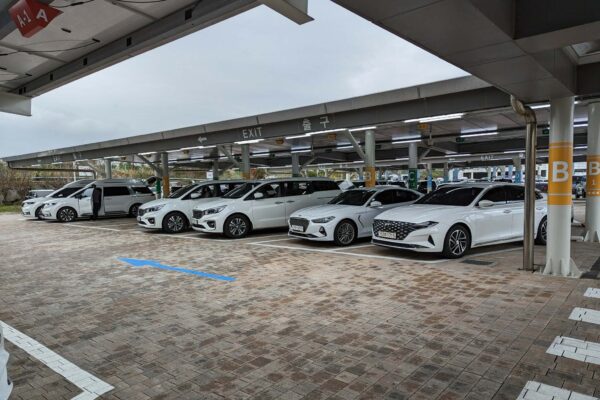
Lotte offers zero-excess CDW which means you don’t need to pay anything for any accidental damages. With zero-excess CDW, they don’t even ask you to check the car when you pick it up, because everything is 100% covered. This is the best cover you can get, and it gives peace of mind.
Lotte has many types of cars, including electric vehicles like the Tesla Model S. Electric vehicles cost more, but they do come with free charging.
Car Pick-Up
Upon arrival at Jeju airport, I thought I’ll just head straight to the rental company shuttle bus area, following the instructions on Lotte’s website. I couldn’t find the bus. I ended up heading back into the terminal, found the Lotte counter, and “checked in”, was handed the same instructions on the website, and only after I pointed out the bus was not there did they hand me a different paper that directed me to a different area.
For most rental companies, the car pick up is not within the airport itself. You head out into the car park area to find free shuttle buses for the rental company. They are frequent enough; Lotte’s ran about every 8 mins. The bus ride is about 10 mins.
I chose the tiniest car because, I was just a party of two. I love this tiny car because it fits in non-standard lots that regular cars can’t fit. I capitalised on this “feature” a few times, squeezing into a lot that others were unable to use.
Take note of the fuel status and the fuel return requirement. In my case, they gave me a car with full tank, and expected a full tank on return.
Spend some time to familiarise yourself with the car, especially gear shift, indicator lights, and various controls.
Driving
Well, let’s see. The biggest thing here is that the cars are left-hand drive, i.e. drivers sit on the left, the cars travel on the right side of the road. The opposite of Singapore. Probably the most difficult thing about getting used to driving on the wrong side of the road is that you need to keep remembering and be very conscious about keeping on the correct side. It is easy to forget, especially when you are distracted, making turns across junctions, turning out of car parks, etc.
If this is your first time driving a left-hand drive vehicle, just make sure you keep your eyes on the road and focus on driving safely. Get someone to help with navigation and wayfinding. Do not try to do too many things at the same time. Accidents happen easily when you are distracted.
If you’ve never driven a left-hand drive vehicle, please take a moment to consider where the corners and edges of the vehicle are. Get someone to stand outside at the far corners, if necessary, to help you orientate yourself to this new perspective of the vehicle. Make sure you keep in lane, and take care during turns that you give sufficient clearance.
Jeju has many speed cameras, and their speed limits are quite low. Sometimes, even as low as 35 km/h in school or elderly zones. 60 km/h is common. This is a good thing for tourists. You don’t feel the pressure to drive fast. You can drive slow, and be careful, and pay more attention to everything happening around you.
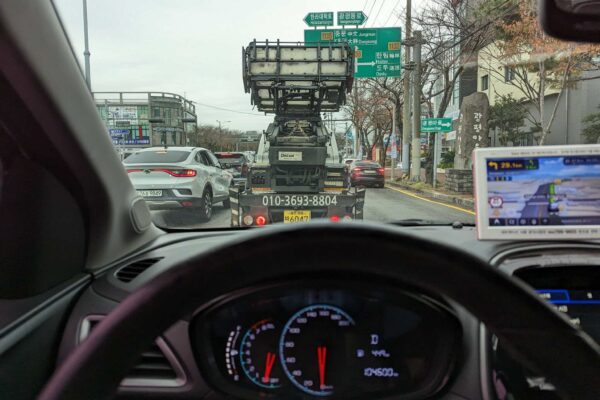
Traffic is usually light outside the city. Within city areas, traffic is heavier, but also slower, which like the above, is a good thing.
Generally, apart from driving on the right side of the road, it’s not complicated or hard to figure out Jeju driving. Just bear in mind a few things:
- They have right turns on red by default, which means unless otherwise indicated, you can turn right on a red light if all is clear. This is similar to left turn on red in Singapore, which applies only when it is specifically indicated. (Though I’ve not seen this in quite a while now, I wonder if this scheme is still practised?)
- If there is a signal for a left turn, that means you must wait for a left turn light before making the left turn.
- Bus lanes are indicated with blue lines. They work like in Singapore. Solid means do not enter; dotted means you can enter/exit. These apply during rush hours. Double blue lines are like our red bus lanes that apply all day, except late nights. I don’t know the exact timing for “rush hour” and “all day”, so just follow what others are doing.
- Roundabouts work like in Singapore except they run anti-clockwise. Vehicles already in the roundabout have right of way over those entering. Funny thing, I found that even the local drivers there don’t seem to understand how roundabouts should work, much like it is the case in Singapore too!
- If you come to an uncontrolled junction (i.e. no traffic lights) and all roads seem equal (i.e. no major or minor road), the broad rule of thumb is that the first fella that reaches the junction gets to go first. Take your turn. This is like an all-way stop in the U.S., for those familiar with driving there.
- I often see traffic lights that are blinking amber or blinking amber and green alternately. I’m not sure what they mean. It seems other drivers just drive through. When in doubt, see what the locals do.
Incidentally, rental cars have this character, circled in blue in the photo below, in their licence plate. If you see another car like this, it’s a rental, and likely the driver may be as lost as you. If you are trying to figure out which are cars are driven by locals, look at other kinds.
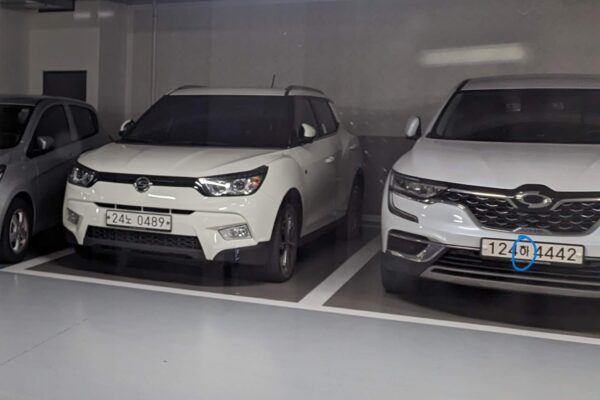
Roads within the city areas are lit at night. Outside the city, major roads like highways are lit. Otherwise, you may find roads that are unlit. In my experience, even on unlit roads, as long as there’s other traffic, there’s enough light to see things well enough. So if you’re going from a major place to another major place, chances are you’ll not be alone. Just don’t be travelling late into the night outside the city.
Car Navigation
Google Maps does not provide navigation in South Korea due to some silly government restrictions. The go-to Korean mapping apps are Naver Map and KaokaoMap, which you can get on Android and iOS. These are designed for use in South Korea, and they do seem to be quite good. Remember to change the app’s language settings to English so that it will be easier to figure out how to use the app. These apps can also help with public transportation like bus and subway.
Better yet if you have an in-car navigation system that supports English. My car type was not supposed to come with English in-car navigation. However, it seems like Lotte was probably in the process of upgrading the cars and mine actually did have English in-car navigation after all. Lucky me.
Having only used Google Maps most of my time ever with driving navigation (yeah, not counting the times from Nokia phone navigation), the in-car navigation system here is amazing. They give plenty of details about speed limits and speed cameras. They even tell you about averaging speed cameras, when the section starts and ends, and computes your average speed over the distance.
Navigation in Jeju, or South Korea in general, was something new to me. You can search for destinations by their phone numbers. Basically, the system has a database of phone numbers, their associated businesses or place, and the addresses. You can still input addresses if you so wish, but searching by phone number is convenient.
I found it interesting that the in-car navigation sometimes sends me down what might look like a small residential road that, in all likelihood, was not meant to be a high-use route to get between places. These small roads were at times barely wide enough for another car in the opposite direction to pass! It was probably a short-cut of sorts.

While I did get to where I wanted to go, I wondered if the residents might be annoyed with random traffic coming through their small roads.
Car Parking
Parking in many places is plentiful and free. This will be the case in most tourist attractions around the island, including museums, aquariums, waterfalls, caves, etc.
You can also find free streetside parking in the city area, though it is more common to see paid parking, including parking structures. I went to one that had a manned payment booth that accepted cash. This is the simplest I guess. At another place, the exit was unmanned, and although it appears that credit cards should have been accepted, the system was not working. A local driver came to my rescue to pay with his card, and I reimbursed him in cash.
With a car, you can probably have a greater selection of hotels to pick from, without concern about accessibility to public transport. Hotels usually include free parking. The hotel I stayed at had a mechanical parking system on top of regular lots.

If I come back late, I’d have to use the mechanical parking system.
Buying Fuel
I got a petrol car. Make sure you know the kind of fuel your car uses. Most gas stations sell both diesel and petrol. No worries, they have standard colours: green for diesel, and yellow for petrol. It is easiest if you can find a manned station, since the pump attendant will take care of things for you and with whom you can settle payment. Credit cards and cash are accepted.
Self-serve pumps are often clearly identified. If you go to one, well, you’ll have to figure things out yourself. Let me suggest this blog post to guide you. Hopefully you find a newer pump that has English language. In the worst case, there’s always Google Translate.
Note that there are also LPG stations. They are clearly labelled too, so don’t drive into one. LPG stations won’t have petrol.
If you decide to pick an electric car, use the in-car navigation to find charging points. The in-car navigation also helps you find petrol stations but since there are plenty around, you probably don’t need to have to purposely use it to navigate to one.
Returning the Car
I returned the car at Jeju airport (well, outside, connected via their free shuttle). Most people will likely do this. Make sure you plan enough time to top up your fuel, get to the rental company, return the car, catch the shuttle, and reach the airport in time for check-in and any other thing you plan or need to do at the airport like meals or shopping.
The return was quite straightforward for me. I was done in 3 mins, and was fortunate that an empty shuttle was waiting for me to depart. I probably spent no more than 5 mins at the rental company.
Driving Tips
There are a few things to take note if you are new to driving in another country, especially with left-hand drive, and in winter conditions.
We do not have winter in Singapore, so here’s something to take note when you drive in cold wintery conditions. Wet roads can be very slippery and dangerous. If the road looks merely slightly wet, but when it is very cold like around 0°C, there could be a thin layer of ice on the road. This is extremely dangerous. Go very slow. This is one of those conditions that doesn’t seem at all like a threat, but it is.
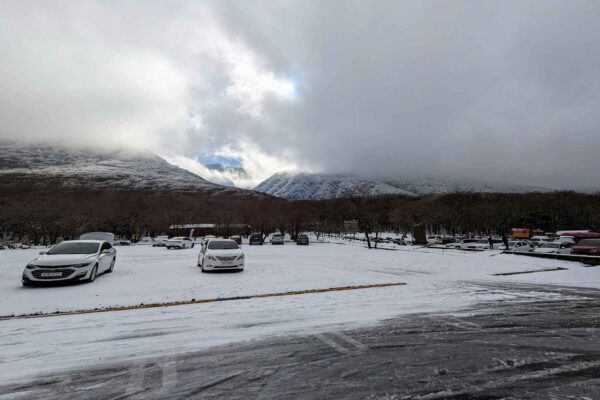
It’s easier to see snow that is there. Remember the tyre’s grip on the road is affected by snow. Avoid sudden changes in motion, be it hard acceleration, braking, or turns. It is easy to get into a skid.
If you encounter fog, or perhaps visibility is impaired for various reasons, drive slow, turn on headlights and hazard lights. You want to make sure you can be seen, and at the same time, you need to make sure you can see what you are driving into ahead of you.
Unless you’re a seasoned overseas driver, I don’t recommend night driving right-away when you arrive in Jeju, or at least not a long drive across the island at night. So, plan your itinerary so that your flight gets in early enough for you to pick up your car and drive to your hotel in good daylight. Otherwise, maybe, pick up your car another day. Sunset is quite early in Jeju (by Singapore standards). I picked a hotel in Seogwipo, on the other side of the island from Jeju airport. It’s not far, but between trying to figure out left-hand drive and the low speed limits in Jeju, the 43 km or so distance takes over an hour. Yeah, some travel guides will tell you 39 mins. I don’t know how they do 39 mins, but I suggest plan your itinerary such that you don’t need to rush.
Enjoy the Drive
Having a car gives you tremendous flexibility to plan and enjoy your tour. You can go anywhere you want, any time you want. You can choose to spend more time at some places, or cut short some visits. You can make up your plans on the go, without constraints from schedules and accessibility of buses and other transport. Furthermore, you can have more choices of hotels to stay at, since any place is now reasonably accessible.
I don’t have a place-by-place driving itinerary to recommend, but my simple suggestion is to go by areas of the island. For example, I did (with accommodations in Seogwipo):
- Day 1 (arrival): Drive down south to Seogwipo, dinner and sights in the city
- Day 2: Places in the south and west of Jeju. Plenty of waterfalls, museums, beach/coastal sights, etc.
- Day 3: Places in the east and northeast of Jeju. E.g., that cliff, cave, aquarium, etc.
- Day 4: Central island (Hallasan), Jeju City, and northwest.
- Day 5: (departure): Drive back to Jeju airport. You could make time for one or two quick stops along the way, depending on your flight time.
It’s quite a leisurely itinerary. No rush. It’s a holiday. Don’t like rushing around.
Hi Zit Seng, this is a very useful post on driving in Jeju. Thanks for sharing. I have two questions. I booked Hertz online and based on some reviews I read, is Hertz company actually the same as Lotte rent a car? Also, how much more did you pay to get zero excess coverage? Thank you for your help.
I think Hertz has a partnership with them. (But IIRC the price was quite different from what Lotte themselves offered.) I paid 35,500KRW for Zero CDW for the 4 day rental.
Hi, chanced upon your blog whilst researching about driving in Jeju. Seems like most car rentals provide 0 CDW, so is it necessary to purchase extra insurance for car rental?
If you mean another extra insurance on its own, no. But won’t hurt to make sure that your travel insurance itself also covers rental, you know, just in case. Most travel insurance do.
Hi. Is the amount of 35,500 KRW covers both the rental and insurance?
The 35,500 KRW is for the CDW (i.e. insurance) only. It covered all 4 days of the rental.
Hi Zit Seng, thank you for this very informative article on driving in Jeju. it sure is very helpful for my coming trip. Did you stay in Jeju city for your entire trip or in other regions too. Mind sharing the hotels as I am having problem trying to find out where best to stay for my 5 nights in Jeju.
I stayed at Shin Shin Hotel Seogwipo the whole time. Decent place, budget friendly, basic amenities. Room has a washer, breakfast included (quite good). Small convenience store across the street. Olle Market is a very short drive away. I wouldn’t mind staying there again if I am in Jeju; though now I also realise the convenience and ease of driving around actually opens up so many more opportunities to explore. 🙂
Hi Zit Seng, which car model did you rent for 2 people? I can’t seem to find the smaller cars option on Lotte
Chevrolet Spark. There’s also Kia Morning in the same category.
Hi Zit Seng,
Thank you SO much for sharing your experience. I am heading to Jeju next week actually, and you gave me such great insight. Thank you!
Do you have any idea if returning the car at a super early hour, how does it work? Scoot recently changes their flight time, departing at 7:30am! So meaning, I will have to return the car at 5:00 or 5:30am. Not sure if the car company (Lotte) open already or not? I tried searching for more info but couldn’t find any.
If you have a clue, please let me know. Thank you loads!
Oh wow, that’s early! I don’t know if they have after-hours drop-off like some rentals do; I suppose email them to ask? But even if they are open, you’d also need a way to get to the airport after that, since the free shuttle service most likely won’t be operating. I think it might be better to return the car the night before and stay close to the airport.
i think for my family of 5. normal sedan car cannot put in all 5 medium luggage.? right..hmm…got to book MPV or CRV?
I think normal sedan would be a tough fit. I suppose the “medium” luggage would still be fairly large, right? Then add carry-on and such. If hotel is near airport, one option is to get the car after checking into the hotel. I.e. the airport-hotel transfers go by some other way.
Thank you for your great information. I am thinking of going to Jeju next year, I was hoping specifically to stay some where quiet. I jus need a complete break . did you on your travels com across a really quiet area. Thank you
Thank you for the information. Can I go to Jeju airport to book the car. Or will it be a good idea to book online. I’m.going in November and not sure the condition of the road.
I’m pretty sure it will work better to reserve in advance. Like in my case, I get a better price too.
Hi Zit Seng. Great and useful blog as I’ll be going to Jeju next month and is looking at renting a car there. Does the insurance include theft? The Lotte’s website does not mention this.
By the way, I do find the rental rates (inclusive of CDW insurance) are rather attractive as compared to major car rental platforms. It seems too good to be true. Did you notice this then?
I’m afraid I don’t know about if theft is covered in particular. I didn’t really think theft would be something to be particularly worried about. Yes, Lotte’s price was a lot better than the other usual international brand names.
Thanks for the sharing! I’m in Jeju now just drove on my first day. I stopped at the red and was puzzled why cars in front of me turned right on red (and I even got horned by the car behind because I didn’t follow to turn as well). After reading your blog now, I understood its allowed! 🙂
Hi Zit Seng,
May I check is it difficult to find a place to park at city area? liked those restaurants, market, etc.
It seems I cant find much parking places from google map…
Thanks,
Ton
There are either parking structures, or roadside/street level parking. Not difficult to find something around on a typical day.
Hi, did you use snow chains on your rental car?
No. Wasn’t really snowing anywhere when I was there, except up in Hallasan.
Hi Zit Seng
Could you please provide insights on how does the mechanical car parking work and are there any restriction to the types of car. Some accommodations mention this type of parking. Thanks very much.
Do you mean how it works from a driver’s perspective? Actually, the one in my hotel has an attendant, so I just position the car outside the “lift”, and the attendant takes over. There are several such systems in Singapore, e.g. Thomson Medical Centre, where an attendant also does the driving into/out of the lift for you. If ever you had to drive into the lift yourself… it’s not very different from, say, the car park lift at Peninsula Plaza. (Peninsula Plaza’s system is purely just a lift… it just brings the car to another floor, and you still got to drive yourself there.) The mechanical car park at Changi Village, I haven’t been there but I understand that you do have to drive into the lift.
PS: Sorry I just realise you may not be based in Singapore. I suppose in the ideal case, they have an attendant and you can just think of it as valet parking, someone takes care of the car. If you had to handle things yourself, you basically drive the car into the lift following the instructions/guide on positioning the car, then exit the lift. There will be instructions on how to retrieve your car later (i.e. making sure you are the correct owner of the car), and when the lift arrives with your car, you just get in and drive it out.
Hello,
Is insurance required for driving in Korea? If yes, do you have any recommendation for the insurance? Thank you!
I got whatever the car rental company offered, plus making sure that my own travel insurance will cover rental car.
Do you recommend 80 yr senior drive in Jeju?
I’m safety conscious. If the person can drive well in Singapore, I don’t think Jeju would pose any additional challenges. But in a new city, driving on the wrong side of the road, etc… just take the same care like anyone else ought to do. (i.e. as in this post :P).
Does your IDP contains korean words?
Don’t have it with me atm… But I highly doubt so.
hi, I am going to Jeju in December, after reading your post to reserve the car earlier, but from the Lotte-rent-a-car site, I don’t seems to be able to reserve that early. Can I ask how early have you reserved previously?
Hi. I reserved about 5 weeks in advance.
Thank you for your post. very informative
Hi,
Just wanna say thanks to your blog. It really gives me a lot of guidance while planning and actually driving in Jeju. Took away lots of anxiety for my first time driving overseas and doing a left-hand drive on top of that.
Thanks for sharing your experience driving in Jeju. So clear and helpful. Is the parking charges for public or roadside parking in Jeju? is there an App or similar to pay for parking?
Hi! It’ll be free in most out-of-city areas. In the city, proper car parks are chargeable. Streetside appears to be free. I don’t think there was any app (at least not when I was there).
Thanks for this awesome post. It really puts my heart to ease after reading all the useful information you’ve highlighted. I am now more confident heading and driving in Jeju.
Does the car you rent comes with snow tire in default? Or the car rental company just provided the snow chain?
It wasn’t snowing when I was there, except at Hallasan, but not enough that snow chains are needed. (My pics might look like lots of snow but it’s still very driveable.) Not sure what the rental car company arrangements on that are.
Very informative post. I’m planning to be in Jeju 9-17Dec and am actually a bit worried about driving on snowy roads. When were you in Jeju? Is snow only limited to mountain peaks during December and roads are pretty much snow-free?
It was early Dec for me. A friend did get some light snow in Seogwipo in mid Dec, but it is uncommon. The city areas might get a higher chance of snow in Jan, but even then, it will be quite mild. Up in the mountains, of course, expect much more snow. Happy holidays!